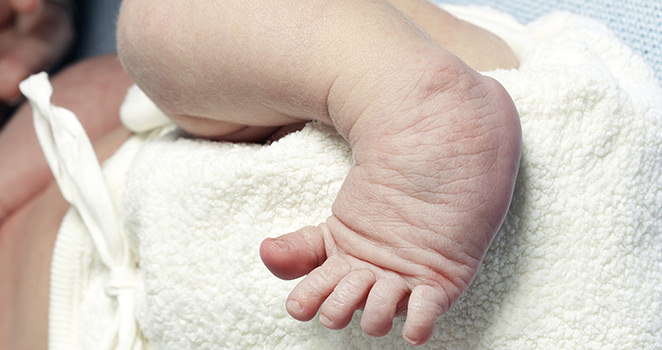Pediatric Clubfoot & Deformities

What are Clubfoot Deformities?
Clubfoot, also known as Congenital Talipes Equinovarus, is a congenital deformity that involves one or both feet. The affected foot or feet have the appearance of being rotated inward at the ankle. People that have this condition and do not get treatment often look like they are walking on their ankles or the sides of their feet when they move. While this condition can be debilitating without treatment, those that get treatment are usually completely cured.
How Many Children Have It?
Clubfoot is one of the more common birth defects. Roughly, one in every thousand babies is born with it. Half of the babies that do have it have it with both feet, which is known as bilateral club foot. Clubfoot occurs twice as frequently in boys as in girls.
Is it a Genetic Condition?
While physicians have studied clubfoot for thousands of years, no one has quite been able to point out the exact cause of the defect. Some think it is environmental factors, others feel it is genetics, and still others feel that it is a combination of both. Majority of medical providers believe it to be caused by multiple factors.
How Does it Develop?
There are many hypotheses about how the condition develops. Some think it comes from a malfunction during the woman's pregnancy. Amniocentesis may cause amniotic leakage, and has been linked with an increase in instances of clubfoot. Bones and muscles in the embryo's foot not developing properly can be an underlying cause. This underdevelopment means the fetus' foot cannot rotate as it normally would, and the baby is born with its foot or feet not properly aligned.
How is it Diagnosed?
Trained medical professionals usually have no problem diagnosing the condition by simply looking at the foot. Most doctors will then x-ray the foot or feet to get a good look at the internal structure. The internal structures are usually more out of alignment if the condition affects both feet. There have been improvements in the ultrasound that can give the physician the opportunity to diagnose clubfoot even before birth, but this is not widespread yet.
How is it Treated?
There are several different methods of treatment. There is a lot of disagreement in the medical community about which one is the best, but there is general agreement on one thing. Whatever the treatment method may be, it needs to be started as soon as possible. This is because the baby's bones, muscles, and ligaments are the most flexible shortly after birth.
The Ponseti method is one of the most popular techniques used to cure clubfoot. This method involves putting braces on the baby's feet that gradually force the feet into alignment. This is usually begins within 14 days of birth.
The French method is a newer technique that is starting to gain widespread acceptance. This method involves gently and gradually stretching the feet into alignment and holding the feet in place with tape after the stretching has occurred. As the name suggests, this is most common in France, but some American hospitals are starting to do it.
Minor surgery is usually needed on children being treated with both the Ponseti and French methods. This surgery is called a tenotomy and involves clipping the Achilles. Some children do not need it, but roughly, 90% do.
Major surgery is sometimes performed on clubfoot patients, but this is relatively rare. Major surgery may cause a great deal of scar tissue to develop inside the child's foot. This will cause the child problems with using their foot, which defeats the purpose of the procedure. In fact, the child may end up needing additional surgery to get rid of the scar tissue.
When there is no alternative and no other treatments have worked, surgery can be performed to correct clubfoot. The surgery involves lengthening the muscles and tendons and easing the foot gently into position. After surgery, a cast is immediately put on the affected foot. When the cast is removed, a brace is worn to prevent the foot from returning to the old position.
This surgery is usually done at nine months to one year of age, after trying normal treatment but before the tissue stops being flexible. Even still, a clubfoot that required surgery is likely to be stiffer than a clubfoot cured through braces. However, not getting treatment is not an option. Walking on a clubfoot can damage the foot, ankle, and leg, and result in ridicule from other children.
The foot will not be perfect after surgery, but it will be possible for the child to walk and run normally. The foot will likely be slightly smaller, and the child may still have a slight limp. However, they will be able to lead a normal life.